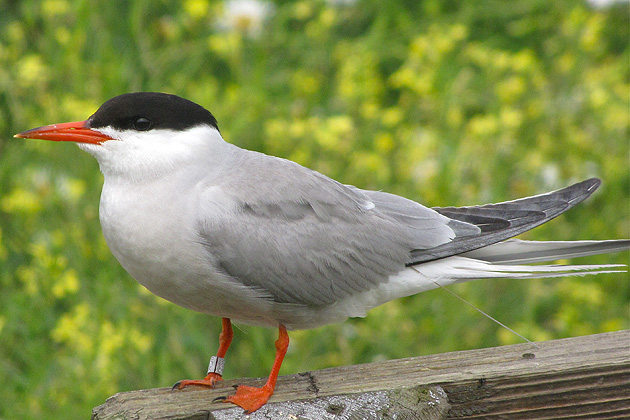
Great Gull Island is home to one of the most important nesting habitats for Roseate and Common terns in the world. The estimated 1,300 pairs of Roseate terns that summer on the 17-acre island at the eastern end of Long Island Sound represent the largest nesting concentration in the Western Hemisphere, and the 9,500 pairs of Common terns are the largest concentration of this species in the world.
But while the terns are currently thriving, their environment is being overrun by nuisance and invasive plant species, such as the wild radish, Black Swallow-wort, and Asiatic Bittersweet, that threaten to destroy their nesting sites.
That is why Juliana Barrett, associate extension educator with Connecticut Sea Grant and UConn Extension has partnered with Helen Hays, the longtime director of the Great Gull Island Project, and others, to stem the tide of unwanted vegetation, even if it means hand-pulling the invaders, one pesky plant at a time.

Good tern nesting habitat requires flat, sparsely vegetated surfaces that are close to water, such as the beaches that line Long Island Sound, according to Margaret Rubega, associate professor of ecology and evolutionary biology, who is also Connecticut’s State Ornithologist.
The problem, she says, is that as humans started building houses, waterside restaurants, marinas, and other structures, the coastline became a place that was no longer hospitable to the nesting birds.
“Prior to all this development there was enough land suitable for nesting so that if a predator discovered a colony of terns, the birds could just get up and move,” Rubega says. “But now there just isn’t much open beach any more, and what little is left is disturbed by people and their pets and the type of predators that tend to associate with human habitation. This makes it all the more important that the nesting habitat on Great Gull Island is preserved.”
A living laboratory

When Barrett received a grant from the Environmental Protection Agency’s Long Island Sound Study, she partnered with the U.S. Fish and Wildlife Service to develop a habitat management plan for the island which is owned by the American Museum of Natural History. Adding the expertise of UConn Extension’s invasive species expert Donna Ellis and that of Joel Stocker at UConn’s Center for Land Use Education and Research, who agreed to map vegetation changes using a quadcopter, or drone, an initial plan was developed with the primary purpose of reinforcing tern habitat.
The project also received help from the National Guard. “Because Hurricane Sandy had destroyed the island’s only dock, we had no way of getting the 14 tons of supplies we needed to build observational bird blinds and terraced nesting boxes out to the island,” says Barrett. “So the Fish and Wildlife Service asked the Connecticut Army National Guard for help, and they agreed to use their Chinook helicopters to deliver the material we needed to the island last April.”
The Guard was happy to participate, she says, because part of its mission includes supporting natural resources projects; and the delivery of supplies to the island also provided valuable training experience for the helicopter pilots.

Plans for the coming nesting season, which begins in the spring, include hand-pulling Bittersweet and Black Swallow-wort, as well as culling some of the Phragmites, a common reed found in wetlands. Because the invasive species are growing at the same time the terns are nesting, this labor-intensive work, which is provided by both student and adult volunteers, will be carefully orchestrated to assure that the nesting and rearing practices of the birds will continue largely undisturbed.
In addition to hands-on efforts to preserve this valuable habitat, Connecticut educators can use the project to help meet the objectives in their Next Generation Science Standards, which are designed to provide a foundation in science literacy for students in the state’s K-12 classrooms.
“With background material provided by Extension and Sea Grant, the work on Great Gull Island can be used to study such diverse topics as ecosystem dynamics, social interaction, and group behavior, and even the engineering challenges presented by the delivery of supplies to the island,” says Barrett.
She also hopes high school students from Ocean Classroom will come out to the island and learn by doing. “There’s nothing quite like hands-on experience to drive home the point that conserving our natural resources is really important,” she says.

Rubega, who has been visiting Great Gull Island since she was in high school, describes the location as a living laboratory for studying habitat management and bird conservation.
“What UConn Extension, Sea Grant, and CLEAR are contributing, both in the way of funding through grants and by helping to recruit the labor to go out and attack the vegetation, is crucial to the continued success of the project,” she says. “We have a national treasure right here in the [Long Island] Sound, and we just can’t afford to let it slip away.”


